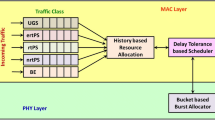Abstract
Future generation wireless personalcommunication networks (PCN) are expected to providemultimedia capable wireless extensions of fixedATM/B-ISDN. This paper presents a scheduling techniquefor PCN based on TDMA and the leaky bucket regulator, thewell known bandwidth enforcement mechanism for fixedATM. The main objective of the proposed technique is toensure fair and efficient treatment of various types oftraffic on the air interface, includingconstant-bit-rate (CBR) voice and variable-bit-rate(VBR) video. Two alternative priority mechanisms areintroduced and their performance is evaluated. Theperformance comparison of the alternatives reveals aninteresting tradeoff between fairness and quality ofservice (QoS).
Similar content being viewed by others
REFERENCES
D. Raychaudhuri and N. Wilson, ATM-based transport architecture for multiservices wireless personal communication networks, IEEEJSAC, Vol. 12,No. 8, pp. 1401–1414, 1994.
R. Guerin, et al., Equivalent capacity and its application to band-width allocation in high-speed networks, IEEEJSAC, Vol. 9,No. 7, pp. 968–981, 1991.
R. Gejji, Mobile multimedia scenario using ATM and microcellular technologies, IEEE Trans. Veh. Technol., Vol. 43,No. 3, pp. 699–703, 1994.
T. Norp and A. Roovers, UMTS integrated with B-ISDN, IEEE Communications Magazine, Vol. 32,No. 11, pp. 60–65, 1994.
A. E. Eckberg, Jr., et al., Meeting the challenge: congestion and flow control strategies for broadband information transport, in Proc. IEEE GLOBECOM ’89, pp. 49.3.1–49.3.5, 1989.
D. Falconer, et al., Time division multiple access methods for wireless personal communications, IEEE Communications Magazine, Vol. 33,No. 1, pp. 50–57, 1995.
L. F. Merakos and F. Li, Integrating data traffic in enhanced-TDMA digital cellular systems, in Proc. Int. Zurich Seminar on Mobile Communications, ETH, Zurich, 1994.
S. Nanda, et al., Performance of PRMA: A packet voice protocol for cellular systems, IEEE Trans. Veh. Technol., Vol. 40,No. 3, pp. 584–598, 1991.
N. Wilson, et al., Packet CDMA versus dynamic TDMA for multiple access in an integrated voice/data PCN, IEEEJSAC, Vol. 11,No. 6, pp. 870–884, 1993.
L. F. Merakos and C. Bisdikian, Delay analysis of the n-ary stack random-access algorithm, IEEE Trans. on Information Theory, Vol. 34,No. 5, 1988.
J. S. Turner, New directions in communications (or which way to the information age?), IEEE Communications Magazine, Vol. 25,No. 10, pp. 8–15, 1986.
J. J. Bae and T. Suda, Survey of traffic control schemes and protocols in ATM networks, Proceedings of the IEEE, Vol. 79,No. 2, pp. 170–189, 1991.
OPNET Modeler, Tutorial Manual, MIL 3, Inc., 3400 International Drive NW, Washington, DC 20008, 1993.
C. Blondia and O. Casals, Performance analysis of statistical multiplexing of VBR sources, in Proc. INFOCOM ’92, pp. 828–838, 1992.
D. M. Lucantoni, New results on the single queue with a batch Markovian arrival, Process. Stochastic Models, Vol. 7, 1991.
C. Herrmann, VBR video in ATM without frame-buffering: Influence of a periodic correlation function on QOS parameters, ATM Workshop, London, Summer 1994.
Rights and permissions
About this article
Cite this article
Passas, N., Loukas, N. & Merakos, L. A Scheduling Technique Wireless Personal for Bandwidth Communication Allocation in Networks. International Journal of Wireless Information Networks 4, 55–62 (1997). https://doi.org/10.1023/A:1018833722435
Issue Date:
DOI: https://doi.org/10.1023/A:1018833722435




